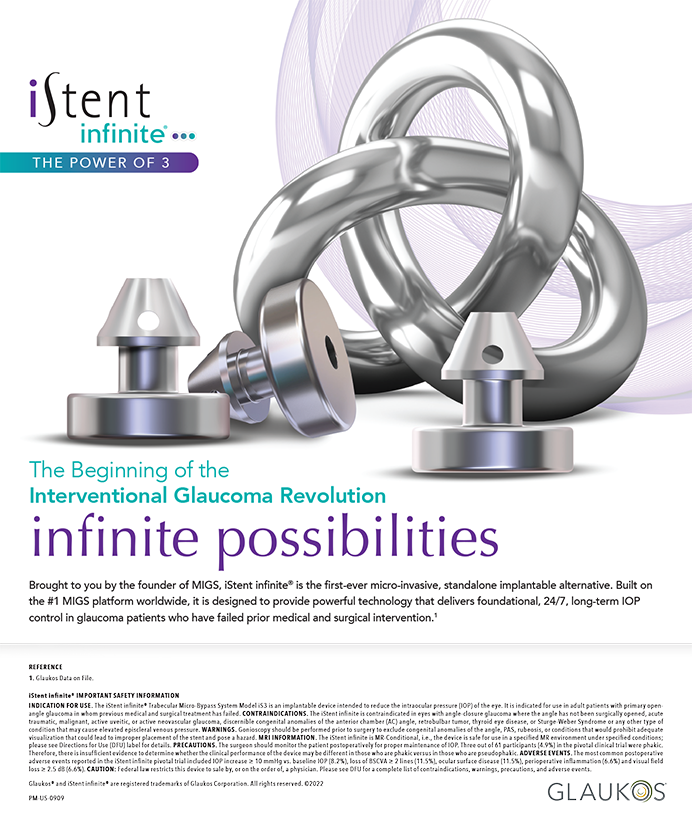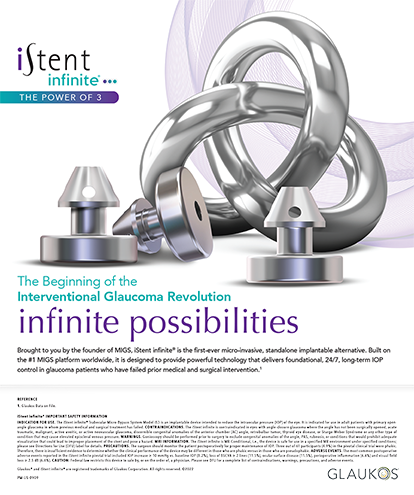Femtosecond laser cataract surgery is relatively new, but it has evolved considerably over the past 3 years and now has a prominent place in cataract surgery throughout the world. As with all new technologies, a learning curve has been associated with the use of the laser for cataract surgery. Initially, we attempted to maintain our standard phaco technique, but we subsequently recognized that several major changes were needed for us to take full advantage of the potential of laser cataract surgery and to minimize complications.
INCISIONS
Originally, we made our incisions at the limbus, but the laser is blocked by the limbus and by blood vessels. For this reason, we have moved our incisions more anteriorly. They are also uniformly longer than they were in the past, they self-seal more reliably, and they induce a more standardized astigmatic effect.
CAPSULOTOMY
We generally created a capsulotomy that was approximately 5.5 to 6 mm in diameter. After adopting the femtosecond laser, we began to make a 4.8-mm capsulotomy. The smaller size ensures that the edge of the capsule overlaps the IOL for 360º to produce a more reliable effective lens position and refractive result. The reduction was possible, because the laser divides the lens into quadrants, making it easier to remove without our bringing the nucleus into the iris plane or anterior chamber.
When we first started performing laser cataract surgery, we assumed that all of the capsulotomies were free-floating. That has turned out to be the case in the great majority of cases, but there is always the potential for one little tag of attachment that can result in a radial tear if the capsule is pulled abruptly. For this reason, if we have the least suspicion of a primary adhesion, we follow the plane of the capsule in a circular fashion when we move the capsule.
HYDRODISSECTION
The most important technical change we believe we have made is that we are less exuberant with our initial hydrodissection. In the presence of a smaller, perfectly round capsulotomy, vigorous hydrodissection will at times cause the lens nucleus to vault forward, occluding the anterior capsule, creating a capsular block syndrome, pushing the fluid posteriorly, and possibly damaging the posterior capsule. Michael Lawless, MBBS, FRANZCO, FRACS, and his group have described this phenomenon; they studied his first several cases of laser cataract surgery and noted two dropped nuclei.1 Simply reducing the pressure applied to the hydrodissection resolves the problem. Some surgeons are actually no longer performing hydrodissection, because they find that the laser creates a pneumodissection.
DIVISION OF THE NUCLEUS
We used to create a central groove. Now, we sculpt the central doughnut we have created with the laser to create a hole in the center of the nucleus. In the past, we split and then chopped the lens with a standard chopper. We now employ a chopper with an arc that fits nicely into the doughnut hole created in the lens to increase the contact area between the lens and the instrument (Figure 1). We further split the lens with the phaco probe to create four quadrants that divide much more easily. The larger surface area of the circular chopper also provides a greater contact area for soft nuclei, which can sometimes be the most difficult lenses to separate.
CATARACT EXTRACTION
During standard phacoemulsification, we use peristaltic vacuum to hold the nuclei, which requires full occlusion of the tip. After the use of the femtosecond laser, we find that the quadrants are mostly free-floating. In our experience, the Venturi mode brings the lens nuclei to the center without the need for full occlusion, which makes quadrant removal extraordinarily rapid.
CORTICAL CLEANUP
One of the easier aspects of traditional cataract surgery, cortical cleanup is difficult after the use of the laser for two reasons. First, there are no free cortical edges to grab onto with the I/A handpiece. More importantly, the hydrodissection plane used to be located between the capsule and the cortex, cleaving the cortical material and making it easier to remove. During laser cataract surgery, we leave a 500-μm cushion between the cortex and the capsule so that the fluid wave now passes anterior to the capsule, through the new plane we have created, so there is very little separation of the cortex from the capsule. In our experience, performing hydrodissection at the conclusion of the phacoemulsification (Figure 2), when only the cortex remains, dramatically simplifies this aspect of the procedure.
CONCLUSION
We have changed every aspect of our phaco technique. In so doing, we find that we have increased the safety of laser cataract surgery, and we hope that the techniques we have described will make adopting laser cataract surgery easier for other surgeons.
Eric D. Donnenfeld, MD, is a professor of ophthalmology at NYU and a trustee of Dartmouth Medical School in Hanover, New Hampshire. He is a consultant to Abbott Medical Optics Inc., Alcon Laboratories, Inc., Bausch + Lomb, and Katena Products, Inc. Dr. Donnenfeld may be reached at (516) 766-2519; ericdonnenfeld@gmail.com.
Erfan J. Nadji, MD, is a cornea fellow at Ophthalmic Consultants of Long Island in Rockville Centre, New York. He acknowledged no financial interest in the product or company mentioned herein. Dr. Nadji may be reached at erfannadji@gmail.com.
Jonathan Stein, MD, is in practice at Ophthalmic Consultants of Connecticut in Fairfield and is a clinical assistant professor at the NYU School of Medicine in New York City. He acknowledged no financial interest in the product or company mentioned herein. Dr. Stein may be reached at steinjonathan@hotmail.com.
- Roberts TV, Sutton G, Lawless MA, et al. Capsular block syndrome associated with femtosecond laser-assisted cataract surgery. J Cataract Refract Surg. 2011;37(11):2068-2070.


